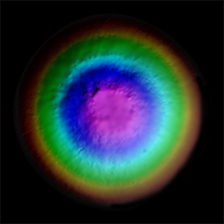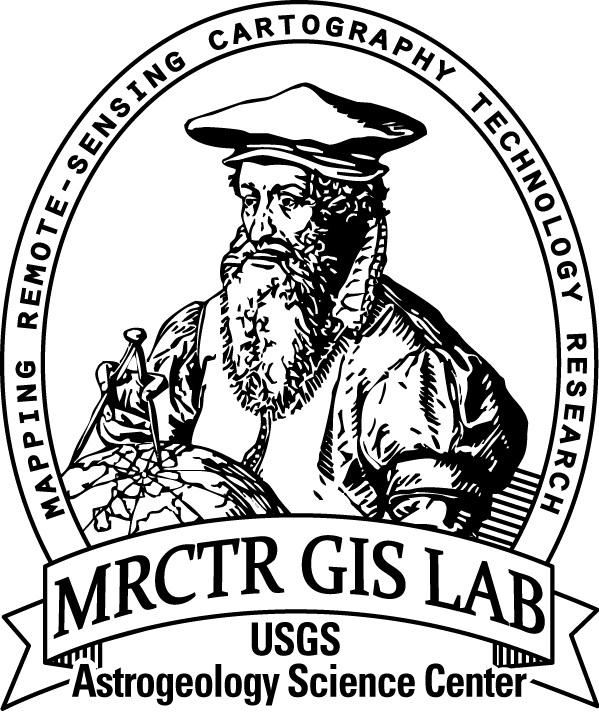Venus Magellan Global Topography 4641m
- Primary Authors
- Magellan Team
- Originators
- Peter Ford, Gordon Pettengill, Fang Liu, Joan Quigley
- Publisher
- USGS Astrogeology Science Center
- Publication Date
- 1997-12-18
- Abstract
- Product Information: The represents the version 2 (1997 release) of the Global Topographic Data Record (GTDR-SINUS.3;2). The range to surface is derived by fitting altimeter echoes from the fan-beam altimetry antenna as a function of time to Hagfors' radar backscatter model templates. The ranges are subtracted from the spacecraft radial coordinate (derived from Doppler tracking), yielding measurements of planetary radius. The data are filtered to remove low-frequency errors in the in-plane elements of each spacecraft orbit, and then originally re-sampled into sinusoidal, Mercator, and north and south polar stereographic projections at a resolution of 5 kilometers per pixel (4641 meters per pixel [m]). Each GTDR pixel is represented by a 16-bit integer. Pixels lying outside the domain of the projection are set to NoData (-32768). In all images, pixels with unknown or unmeasured values are also set to NoData. The remaining values have been processed into elevations with a data range of -2951 to 11687 meters. To return these values from elevation back to radius values use the following equation: Radius = DN + 6051000.0 Note: There exist photoproducts that are identified as GxDRP (where x is E (Emissivity), S (Slope), RE (Reflectivity), or T (Topography)) however, they are not generated from the digital GxDR products. They are instead produced from the Magellan ARCDR (Altimetry and Radiometry Composite Data Record) data files. Mission and Instrument Information: The Magellan Mission to Venus launched on May 4, 1989 on board the Space Shuttle Atlantis. The spacecraft arrived at Venus on August 10th, 1990 and was inserted into a near-polar elliptical orbit. The primary mission requirements were to map at least 70% of the surface at a resolution better than 300 meters per pixel and to determine the global relief at such a resolution as to facilitate detailed analysis of tectonic, volcanic, eolian, and impact features. Magellan successfully completed four mapping cycles at Venus. The first mapping cycle lasted from mid-September 1990 to mid-May 1991 focused on fulfilling the primary mission requirements. The second mapping cycle was from mid-May 1991 to mid-January 1992 and was dedicated to filing in gaps in the cycle 1 coverage and obtaining coverage of the south polar region; this cycle resulted in 54% of surfaced coverage and increased the cumulative coverage of the mission to 96%. Cycle 3 was from mid-January to mid-September 1992 and focused on acquiring stereo image coverage; this cycle resulted in about 21% surface coverage and increased total surface coverage to 98%. Cycle 4 was dedicated to gravity observations and as such did not add to the cumulative coverage of imagery taken by the spacecraft (Ford et al., 1993). References: Ford, J. P., et al. (1993). Guide to Magellan Image Interpretation. JPL Publication 93-24 pp. 1-18. https://ntrs.nasa.gov/archive/nasa/casi.ntrs.nasa.gov/19940013181.pdf Ford, P. G. (1991). Global Altimetry and Radiometry Data Records, MIT-MGN-GxDR SIS Version 2.3, 40 p. Software Interface Specification Document (included on GxDR CD-ROMs.)
- Purpose
- Topographic elevation in meters as collected from Magellan altimetry.
Contact and Distribution
- Format
- Digital Elevation Model, Global Mosaic, Remote-sensing Data, Topographic Map
- Access Constraints
- public domain
- Access Scope
- PDS
- Use Constraints
- Please cite authors
- Edition
- 2
- Supplemental Information
- ftp://voir.mit.edu/pub/mg_3003/, https://pds-imaging.jpl.nasa.gov/software/MGN_SAR_UserGuide.pdf
- Native Data Set Environment
- ISIS v3
- Astrogeology Theme
- Topography
- Mission Names
- Magellan
- Instrument Names
- SAR
- Online Package Link
- https://astrogeology.usgs.gov/search/map/venus_magellan_global_topography_4641m
- External File Size
- 65 MB
- Online File Link
- https://planetarymaps.usgs.gov/mosaic/Venus_Magellan_Topography_Global_4641m_v02.tif
- Contact Address
- 2255 N. Gemini Drive
- Contact City
- Flagstaff
- Contact State
- AZ
- Contact Postal Code
- 86001
- Contact Email
- astroweb@usgs.gov
- Currentness Reference
- Publication date
- Progress
- Complete
- Update Frequency
- None planned
- Process Description
- The original PDS release was map projected to Simple Cylindrical and the offset and scaler were applied to return elevation values with the range from -2951 to 11687 meters. This archive was produced by Jason Hyon. Mike Martin (JPL), Gail Woodward (JPL), Peter Ford (MIT), Robert Mehlman (UCLA), and Jason Hyon (JPL) designed the PDS labels and the tables. Florence Moss (JPL) and Jason Hyon developed the software to generate the PDS labels and tables. Raymond Arvidson and Gail Woodward created the catalog templates, with help from Pam Woncik (JPL), Mary Dale-Bannister (Washington University), and Susan Slavney (Washington University). The data and documentation were generated at MIT by Peter Ford, Gordon Pettengill, Fang Liu, and Joan Quigley from data supplied by the Magellan Project. Please direct any questions and comments to the PDS Geosciences Node, geosci@wunder.wustl.edu.
Lineage
- Process Date
- 1997-12-12
- Source Title
- Magellan Global Topography, Emissivity, Reflectivity, and Slope Data Record (GXDR)
- Source Online Linkage
- {http://pds-geosciences.wustl.edu/mgn/mgn-v-gxdr-v1/mg_3002/gtdr/,http://pds-geosciences.wustl.edu/missions/magellan/gxdr,https://pds-imaging.jpl.nasa.gov/portal/magellan_mission.html}
- PDS Status
- PDS 3 Archived
- Attribute Accuracy Report
- Accurate to Control Net
- Horizontal Positional Accuracy Report
- Accurate to Control Net
- Vertical Positional Accuracy Report
- Best Effort
Geospatial Information
- Target
- Venus
- Minimum Latitude
- -90
- Maximum Latitude
- 90
- Minimum Longitude
- -180
- Maximum Longitude
- 180
- Direct Spatial Reference Method
- Raster
- Object Type
- Grid Cell
- Raster Row Count (lines)
- 4096
- Raster Column Count (samples)
- 8192
- Bit Type (8, 16, 32)
- 16
- Quad Name
- Radius A
- 6051000
- Radius C
- 6051000
- Bands
- 1
- Pixel Resolution (meters/pixel)
- 4641.0589
- Scale (pixels/degree)
- 22.7555
- Altitude Resolution
- 1
- Vertical Coordinate System Units
- Meters
- Map Projection Name
- Simple Cylindrical
- Latitude Type
- Planetocentric
- Longitude Direction
- Positive East
- Longitude Domain
- -180 to 180




















